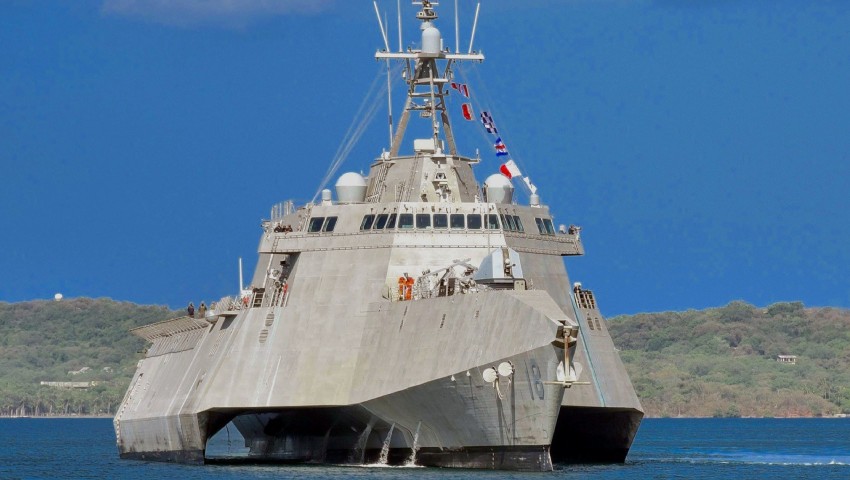Findings from the littoral combat ship (LCS) in the United States, a vessel that boasts a streamlined crew of 40 members, has demonstrated that reduced upkeep while at sea has led to higher maintenance costs on land and more damaged equipment. Will unmanned maritime vessels prove a gamechanger at sea or simply an expensive mistake?
To continue reading the rest of this article, please log in.
Create free account to get unlimited news articles and more!
Simple, cheap and deadly unmanned systems have already proven a gamechanger on the modern battlefield. One need look no further than the recent Armenia-Azerbaijan conflict to see how military commanders have seamlessly integrated unmanned systems into the modern threat environment, and how such simple and inexpensive systems have caused operational-strategic level impacts (see how Azerbaijan allegedly destroyed Armenia’s famed Iskander air defence systems here).
Unmanned systems have yet to reach their apotheosis. Teaming projects like the Loyal Wingman seek to bring unheralded human-robot symbiosis into the conventional battlespace, while the Orca project seeks to introduce the unmanned system into the remarkably challenging submarine domain.
However, while such smaller unmanned systems have already revolutionised the battlefield, recent attempts by the US Navy to mitigate their reliance on crews and embark on the era of unmanned ships has yet to prove successful.
Unmanned systems, still years away
According to Jonathan Panter and Jonathan Falcone in War on the Rocks in December, the US Navy’s littoral combat ships have evidenced the disastrous impact of a premature transition from crewed to uncrewed systems.
Simply, the pair explain that reducing the number of sailors onboard maritime vessels while at sea has led to a greater reliance on even costlier cutting-edge technology and has also resulted in equipment breakdowns going unnoticed.
“While the LCS is not unmanned, it is further on the unmanned spectrum than any other US Navy vessel in operational use, making it the closest real-world test case for future surface fleet architecture,” the pair note of the LCS.
“First, replacing sailors with technology reduced maintenance at the operator level, but increased it at the regional maintenance centre and original equipment manufacturer levels. This raised costs overall, meaning fewer platforms could be purchased.
“Second, minimal manning made platforms less resilient. Fewer sailors meant fewer problems spotted, and less capacity to fix them while underway.”
Unsurprisingly, complex ships require experts at sea to monitor and oversee the operational capabilities of the ship’s systems. If those experts are not onboard, the LCS or unmanned vessels would require difficult at-sea support from nearby vessels.
“But removing personnel from ships also means something else: more complex technical systems. Any unmanned piece of equipment is usually more complex than a manned machine assigned to do an equivalent task. This can make routine and corrective maintenance more costly, and also carries hidden costs by way of the high-level training required to conduct maintenance,” the pair contend.
Although, not everyone shares the pair’s scepticism toward unmanned maritime vessels.
Michael Shoebridge, director of the defence, strategy and national security program at the Australian Strategic Policy Institute (ASPI), argues that the government should consider procuring the ‘Orca’ — an extra-large unmanned undersea vehicle developed by Boeing and Huntington Ingalls Industries for the US Navy.
Five Orcas are scheduled to be built by the end of 2022 as part of a US$274 million ($354 million) contract signed in 2019.
“The unmanned submarine has a range of about 6,500 nautical miles (12,000 kilometres) and can perform dangerous, dirty and dull work like intelligence-gathering, surveillance and deployment of other systems (such as smart sea mines), with a development path up to and including deployment of other weapons to attack adversary ships, submarines and other systems,” Shoebridge writes.
“They will probably work best as part of a manned–unmanned undersea team, less closely tethered but a bit like the rapidly developed ‘Loyal Wingman’ unmanned aerial vehicle that the Royal Australian Air Force is developing and testing with Boeing Australia.”
Shoebridge concedes that there would be “plenty to work out” to ensure the Royal Australian Navy can operate Orcas effectively, but notes there’s a “practical limit” to how much planning and preparation can be done with experiments and demonstrations.
“Concepts for use and ways to resolve difficult problems like tasking and controlling undersea systems will be resolved much faster once navy personnel get their hands on live systems; that’s what’s happened throughout the history of warfare,” he writes.
The ASPI analyst proposes that the RAN collaborates with US Navy, along with US and Australian industrial partners, to develop the Orca, adding that this would “bring the most undersea combat power most quickly to Australia’s military”.
He continues: “It’s also the best way for Defence to create new challenges for adversaries that are thinking of coercing Australia or increasing their military presence in Australia’s near region.”
Shoebridge goes on to write that Orcas working with upgraded Collins Class submarines would “change the calculus around Australian defence” ahead of the delivery of the next-generation fleet.
This, he claims, would also ensure that Australia’s future fleet of submarines and its crews are “designed and prepared” to operate with unmanned systems. Shoebridge argues that Defence has an opportunity to negotiate an attractive deal for the Orca with Boeing, with its commercial business severely impacted by travel restrictions imposed in response to the COVID-19 pandemic.
Cost blowouts
While there is significant evidence to suggest that unmanned systems such as the Orca will greatly enhance Australia’s strategic capabilities and forward posture, Panter and Falcone nevertheless demonstrate that the reduction of sailors onboard the LCS resulted in cost overruns and destruction of vessels as malfunctioning parts were left unattended.
“With time, the projected life-cycle cost savings slowly began to diminish as core crew numbers increased by 25 per cent, and the number of required shore-support personnel tripled,” the pair argued.
“With fewer sailors onboard to inspect engineering spaces, for example, one hull type suffered repeated engine casualties that simply went unnoticed.”
However, while it is hoped that greater digitisation of naval vessels would minimise this ongoing threat, the US Navy is facing largescale funding issues with an aging fleet and competing priorities.
According to Reuters, the Defense Authorization Act 2022 has provided sufficient funding to the US Navy to purchase “13 battle force ships including two Virginia Class submarines made by Huntington Ingalls (HII.N) and General Dynamics (GD.N) and three DDG 51 Arleigh Burke destroyers also made by General Dynamics”.
The act further provides $7.1 billion to support US operations in the Indo-Pacific as part of the Pacific Deterrent Initiative (an increase of some $2.1 billion). The investment is expected to support US capabilities in the region, including the defence of Guam, which some analysts have suggested is over reliant on disconnected missile systems for defence.
While the act does provide provisions for the development of further naval capabilities and protection of US naval bases, not all military analysts appear content with the House and Senate armed services committee’s budgetary recommendations with a sub-optimal allocation in budgetary funds.
It has been revealed by numerous media outlets that the committee provided funding for an additional 12 Boeing Super Hornets, despite the Pentagon arguing that none should be purchased as they will be unable to overcome the threats posed by the modern fighter aircraft used by the US’ adversaries. Rather, the capital could be redirected into researching and developing sixth-generation fighter aircraft.
Despite the relatively modest price tag of the Orca and other unmanned systems, the US Navy’s competing priorities may result in a diminishing willingness from some in the military to take a gamble on unmanned technology at sea after lessons from the LCS scenario.
How autonomous would such systems be?
The degree of autonomy under which unmanned systems should operate has caused widespread debate among military and academic sources.
There appears no shortage of evidence to suggest that the automation of decision matrices driven by all available information and data for unmanned weapons systems could enhance a Commander’s judgement. Indeed, even von Clausewitz himself noted that war “is wrapped in a fog of greater or lesser uncertainty.”
One of the greatest examples of which came in 1988 when the USS Vincennes shot down an Iranian passenger jet. It was later determined that the operator – rather than the semi-automated Aegis weapons system – was in control.
Nevertheless, while many in the industry and country at large may be willing to automate weapons systems yet further, such zeal may not be evidenced among military commanders who would be held liable if autonomous weapons systems under their control commit war crimes.
In fact, the US Department of Defense directive 3000.09 outlined that military commanders at all times must have “appropriate levels of human judgement” over decisions undertaken by autonomous systems, hopefully mitigating machine-determined violations of jus in bello.
Your say
How should Australia approach the concept of unmanned vessels at sea? Will the concept lead to greater cost spikes or will the ongoing digitisation of ships enable the Navy to overcome maintenance difficulties at sea?
As always, join the discussion in the comments section below.
Get involved with the discussion and let us know your thoughts on Australia’s future role and position in the Indo-Pacific region and what you would like to see from Australia's political leaders in terms of partisan and bipartisan agenda setting in the comments section below, or get in touch with
Liam Garman
Editor – Defence and Security, Momentum Media

 Login
Login








